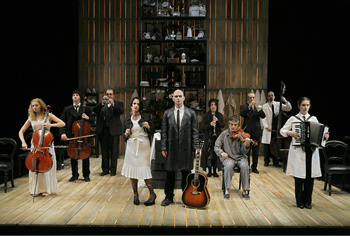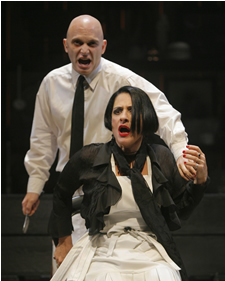
Brilliant Gestures
By Caridad Svich
Sweeney Todd: The Demon Barber
of Fleet Street
By Stephen Sondheim and Hugh Wheeler
Eugene O'Neill Theatre
230 W. 49th St.
Box office: (212) 239-6200
The new Broadway production of Stephen
Sondheim and Hugh Wheeler's Sweeney Todd: The Demon Barber
of Fleet Street, directed and designed by John Doyle, bristles
with imaginative energy and supple strength. Stripped down to
a ten-member singer-actor-musician ensemble led by Michael Cerveris
and Patti Lupone, the cast makes even a longtime fan of the show
feel she is hearing the score for the first time. Sondheim's score
(with lyrics by Sarah Waters) is indeed the life-blood of this
bitterly macabre and strangely tender 1979 musical. What mainly
engages the eye and ear this time, however, are Doyle's choices,
the intricate, imaginative dance he asks of his audience.
This is a ritualized, madhouse re-telling
of the Sweeney story on a stage flanked by a cross-like formation
of coffins on a wall of used and unused props and relics. Doyle
dresses the musical down to the bone, demanding that the audience
fill in the "scene," as it were, and at the same time look closely
at it. This act of visual doubling--the real stage set against
imagined scenes forged from the re-enacted story--is further complicated
by having actors playing their own instruments. The young, doomed
lovers Johanna (Lauren Molina) and Anthony (Benjamin Magnuson)
play their love duets accompanied by their cellos. Judge Turpin
(Mark Jacoby) shares trumpet phrasing with The Beadle (Alexander
Gemignani) as they scheme. And young, crazed, initially straight-jacketed
Tobias (Manoel Felciano) plays the violin as if the strings were
extensions of his feverish, tormented mind. The multiple tasks
of the actor-singer-musicians invite complex responses from the
audience and the cast. Characters who die in one scene pick up
their instruments in the next, suggesting that the telling of
this story is never-ending, and that the murdered are haunted
by their killers even in "death."
The multi-layeredness awakens the audience
to listen sharply, imagine intently, and witness the acting and
musicianship with a measure of attention that is unusual for standard
Broadway fare. While not robbing the piece of its penny dreadful
origins, and the requisite thrills of a story that depicts revenge
with relentless obsession, Doyle's exacting, highly stylized vision
demands much of the audience. There's no seduction by the beauty
of the score or the romance of the performances. The story of
the murderous barber lives, here, in the audience as much as on
the stage.
That is not to say that there is nothing
without the audience, for the recently released cast recording
of this production affirms the magnetic grace and delicate musicality
of the ensemble. Cerveris's Sweeney sits in his lower vocal register,
intoning his loss and vengeance as if from a great un-located
depth. Clad in black leather and heavy boots, shadowed in sculptural
light (evocatively designed by Richard G. Jones), he exudes blank-eyed,
chilly menace: a figure lost to himself, forever exacting loss
from everyone around him.  LuPone's
Mrs. Lovett is a jazzy contralto, casually, cold-heartedly scheming
for adventure while egging her alienated but compliant servant-lover
to kill. Decked out in a tight-fitting black mini-skirt and corseted
top, she is a feral mistress cast in the Wedekind mold. Cerveris
and Lupone's deadly dance of Eros and madness, equally brutish
and intimate, continually captivates even when they are not ostensibly
in a "scene." Felciano's Tobias, from whose point of view Doyle
chooses to tell the tale, is a guileless, childish creature with
the voice of an ardent angel and the stare of a wayward son. His
reading of the ballad "Not While I'm Around," sung to Lupone's
unashamed mother/lover embrace, is so full-hearted that it almost
threatens to break the spell of this relentlessly revisionist,
cold-lit Sweeney and thrust it into the brooding, soulful mood
of a later Sondheim piece like Passion.
LuPone's
Mrs. Lovett is a jazzy contralto, casually, cold-heartedly scheming
for adventure while egging her alienated but compliant servant-lover
to kill. Decked out in a tight-fitting black mini-skirt and corseted
top, she is a feral mistress cast in the Wedekind mold. Cerveris
and Lupone's deadly dance of Eros and madness, equally brutish
and intimate, continually captivates even when they are not ostensibly
in a "scene." Felciano's Tobias, from whose point of view Doyle
chooses to tell the tale, is a guileless, childish creature with
the voice of an ardent angel and the stare of a wayward son. His
reading of the ballad "Not While I'm Around," sung to Lupone's
unashamed mother/lover embrace, is so full-hearted that it almost
threatens to break the spell of this relentlessly revisionist,
cold-lit Sweeney and thrust it into the brooding, soulful mood
of a later Sondheim piece like Passion.
The rush of positive, powerful feeling
from Tobias, however, is ultimately in keeping with the go-for-broke
take on the score from the rest of the performers, whether they
are in romantic counterpoint (in Sweeney and the Judge's duet
"Pretty Women"), in rock n'rollish mania (in Sweeney's "Epiphany"),
or in flirtatiously wistful dreaming (in Mrs. Lovett's "By the
Sea"). Indeed, the power of Felciano's fervor in "Not While I'm
Around" is an effective reminder of Sondheim's ability to place
the beating heart of his scores often in secondary, less showy
roles. Very likely, Doyle's decision to conceptualize this Sweeney
from Tobias's point of view was cued from the score itself--as
director-choreographer Matthew Bourne took his carnal, surreal
approach to Swan Lake from the pulse and swoon of Tchaikovsky's
score. Tobias has pledged his loyalty to Mrs. Lovett and vowed
to protect her from all harm (not knowing that she is complicit
in Sweeney's crimes). He surrenders to her in song, and his vow
becomes the axis from which the rest of the show pivots. As Sweeney's
murderer, innocent, troubled Tobias is the one most haunted by
this lurid story, for it is Sweeney's eyes in death that will
forever follow him as he lives on in the asylum that offers no
true mental sanctuary.
The design is Expressionist throughout,
with an especially compelling and macabre use of a child's white
coffin cradled by Sweeney in the second act. Doyle may have been
influenced by Peter Brook's asylum-set in Marat/Sade
but, again, he seems primarily emboldened by the source material
itself. Radically reducing the mise-en-scene and the
orchestrations from the operatic and brazenly flamboyant stagings
of Sweeneys past (including Harold Prince's remarkable
original production), Doyle seeks to relocate the core of this
burning tale of mad passion and rage, and give it classical meaning
and proportion. Starkly presented, with its violence staged through
symbolic gestures enhanced by flashes of red light and buckets
of blood, it references the lurid thrills of Grand Guignol. Yet
in our age of reproduction and replication, when images of violence
and horror (fictive and real) are all too common, the excitement
of this Sweeney Todd is not in the depiction of violence
but in the knowledge that these figures, however startlingly fashioned
by pulp conventions, are part of our moral order. Their gestures,
full and empty at the same time, re-told yet fresh, are inescapably
human. And the more we listen to Sondheim's score, with its passages
of brilliance, vaudevillian flourishes and mournful cadences,
the more its human-ness, its outrage and wonder at what individuals
are capable of, transforms the cheap thrills into a penetrating
examination of the dangerous aspects of the human heart.
